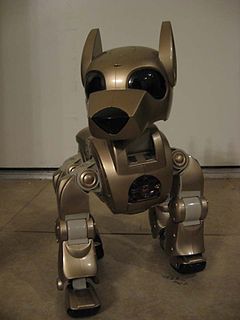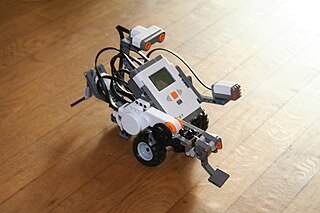
The Apple II is an 8-bit home computer, one of the first highly successful mass-produced microcomputer products, designed primarily by Steve Wozniak. It was introduced in 1977 at the West Coast Computer Faire by Jobs and was the first consumer product sold by Apple Computer, Inc. It is the first model in a series of computers which were produced until Apple IIe production ceased in November 1993. The Apple II marks Apple's first launch of a personal computer aimed at a consumer market – branded towards American households rather than businessmen or computer hobbyists.

A computer program is a collection of instructions that performs a specific task when executed by a computer. A computer requires programs to function.
Python is an interpreted, high-level, general-purpose programming language. Created by Guido van Rossum and first released in 1991, Python has a design philosophy that emphasizes code readability, notably using significant whitespace. It provides constructs that enable clear programming on both small and large scales. Van Rossum led the language community until stepping down as leader in July 2018.

The Commodore PET is a line of home/personal computers produced starting in 1977 by Commodore International. A top-seller in the Canadian and United States educational markets, it was the first personal computer sold to the public and formed the basis for their entire 8-bit product line, including the Commodore 64. The first model, which was named the PET 2001, was presented to the public at the Winter Consumer Electronics Show in 1977.

QRIO was a bipedal humanoid entertainment robot developed and marketed by Sony to follow up on the success of its AIBO entertainment robot. QRIO stood approximately 0.6 m tall and weighed 7.3 kg. QRIO's slogan was "Makes life fun, makes you happy!"

i-Cybie (爱赛比) is a robotic pet that resembles a dog. It was manufactured by Silverlit Toys Manufactory Ltd Hong Kong from 2000 to 2006. i-Cybie was developed for commercial distribution by Tiger Electronics. Outrageous International Hong Kong distributed the electronic pet from 2005 to 2006. The i-Cybie robotic dog responds to sound, touch, movement, and voice commands. The toy robot can autonomously recharge its batteries using a special docking station. I-Cybie was the first mass-produced toy that used advanced voice recognition technology.
Robot software is the set of coded commands or instructions that tell a mechanical device and electronic system, known together as a robot, what tasks to perform. Robot software is used to perform autonomous tasks. Many software systems and frameworks have been proposed to make programming robots easier.

LEGO Mindstorms NXT is a programmable robotics kit released by Lego in late July 2006. It replaced the first-generation Lego Mindstorms kit, which was called the Robotics Invention System. The base kit ships in two versions: the Retail Version and the Education Base Set. It comes with the NXT-G programming software, or optionally LabVIEW for Lego Mindstorms. A variety of unofficial languages exist, such as NXC, NBC, leJOS NXJ, and RobotC. The second generation of the set, the Lego Mindstorms NXT 2.0, was released on August 1, 2009, featuring a color sensor and other upgraded capabilities. The third generation, the EV3, was released in September 2013.

Microsoft Robotics Developer Studio is a Windows-based environment for robot control and simulation. It is aimed at academic, hobbyist, and commercial developers and handles a wide variety of robot hardware. It requires the Microsoft Windows 7 operating system.
The Robopet is a robotic dog produced by WowWee that is based on the biomorphic work of Mark W. Tilden. The Robopet has IR, audio and tilt sensors and is able to wander around autonomously detecting and reacting to objects and sounds. It also performs random 'tricks' such as howling, begging, rolling over and playing dead.

Webots is an open-source robot simulator. It is widely used in industry, education and research. The Webots project started in 1996, initially developed by Dr. Olivier Michel at the Swiss Federal Institute of Technology (EPFL) in Lausanne, Switzerland. Since December 2018, it is released under the Apache 2 license.

A robotics simulator is used to create application for a physical robot without depending on the actual machine, thus saving cost and time. In some case, these applications can be transferred onto the physical robot without modifications.
Natural-language programming (NLP) is an ontology-assisted way of programming in terms of natural-language sentences, e.g. English. A structured document with Content, sections and subsections for explanations of sentences forms a NLP document, which is actually a computer program. Natural languages and natural-language user interfaces include Inform7, a natural programming language for making interactive fiction, Ring, a general-purpose language, Shakespeare, an esoteric natural programming language in the style of the plays of William Shakespeare, and Wolfram Alpha, a computational knowledge engine, using natural-language input. Some methods for program synthesis are based on natural-language programming.

Apache Wave was a software framework for real-time collaborative editing online. Google originally developed it as Google Wave. It was announced at the Google I/O conference on May 27, 2009.
Genibo is a robotic dog produced by the Korean company Dasarobot of Dasatech.

.NET Framework is a software framework developed by Microsoft that runs primarily on Microsoft Windows. It includes a large class library named Framework Class Library (FCL) and provides language interoperability across several programming languages. Programs written for .NET Framework execute in a software environment named Common Language Runtime (CLR), an application virtual machine that provides services such as security, memory management, and exception handling. As such, computer code written using .NET Framework is called "managed code". FCL and CLR together constitute the .NET Framework.

The WonderBorg is a programmable consumer robot kit first released for the Bandai WonderSwan and Microsoft Windows PCs in 2000. It is intended to match both the external appearance and mode of transport of a beetle, with functioning antennae and a six-legged design.














